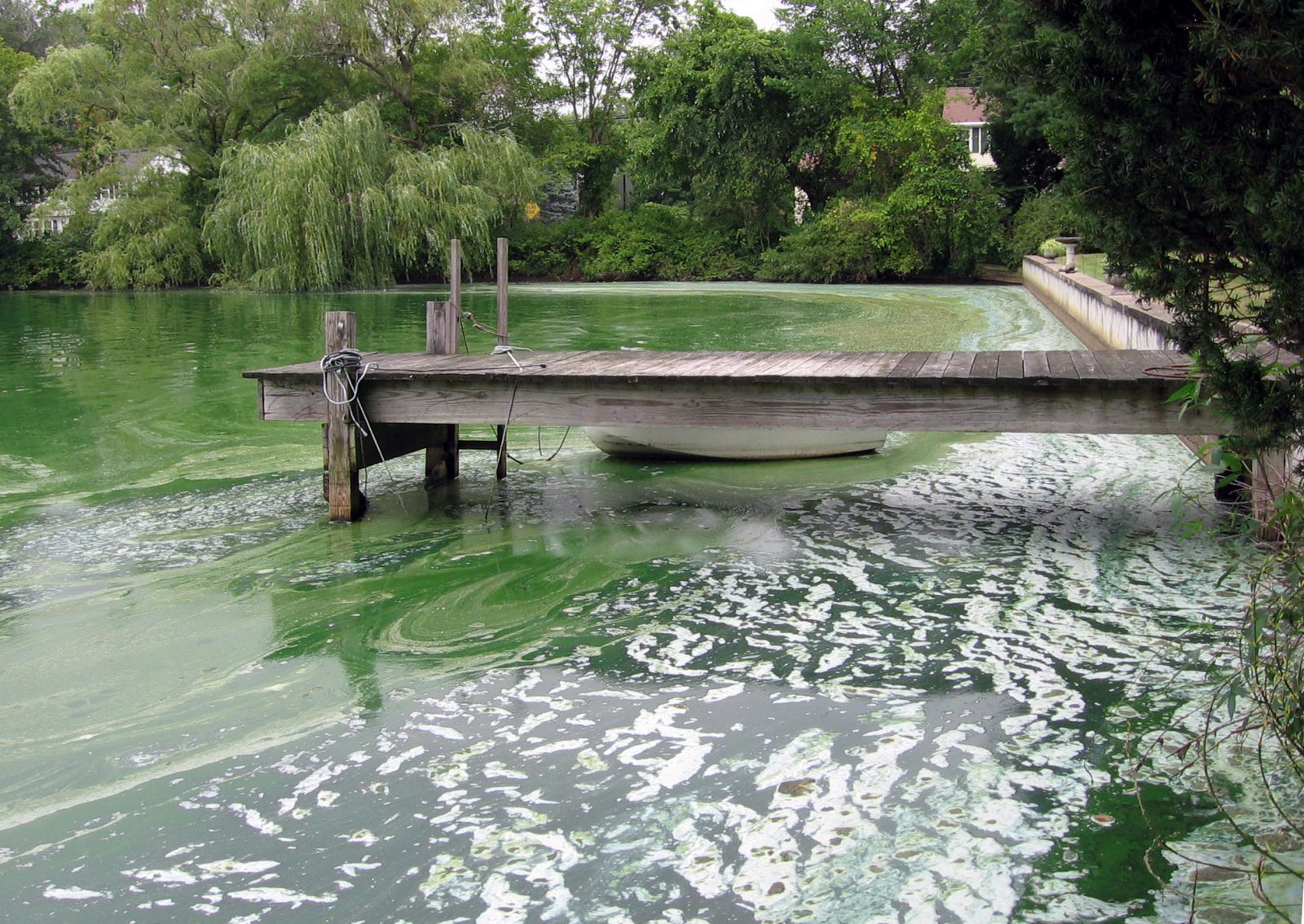
Nutrient Management: Say No to Cyanobacteria if You Want Big Bass
Update: September 7th, 2023
AS SEEN IN Pond Boss Magazine: Written by Industry Experts David Beasley, Fisheries Biologist & Director of Fisheries and West M. Bishop, Ph.D., Algae Scientist & Water Quality Research Manager at SePRO Corporation
Several decades ago, pioneers of the trophy Largemouth Bass industry began connecting the dots on how to consistently grow big bass. Over the years, these innovators continually built on their knowledge to maximize production and develop fisheries from the bottom-up. They had a firm understanding that phytoplankton (microscopic algae throughout the water) was critical to producing those big bass we all daydream about, so they employed fertility programs that involved monitoring the plankton bloom and applying fertilizer when the bloom provided visual clues that additional nutrients were needed. Biologists developed an eye what to look for, and as result, fertilizing ponds became as much of an art as it was a science.
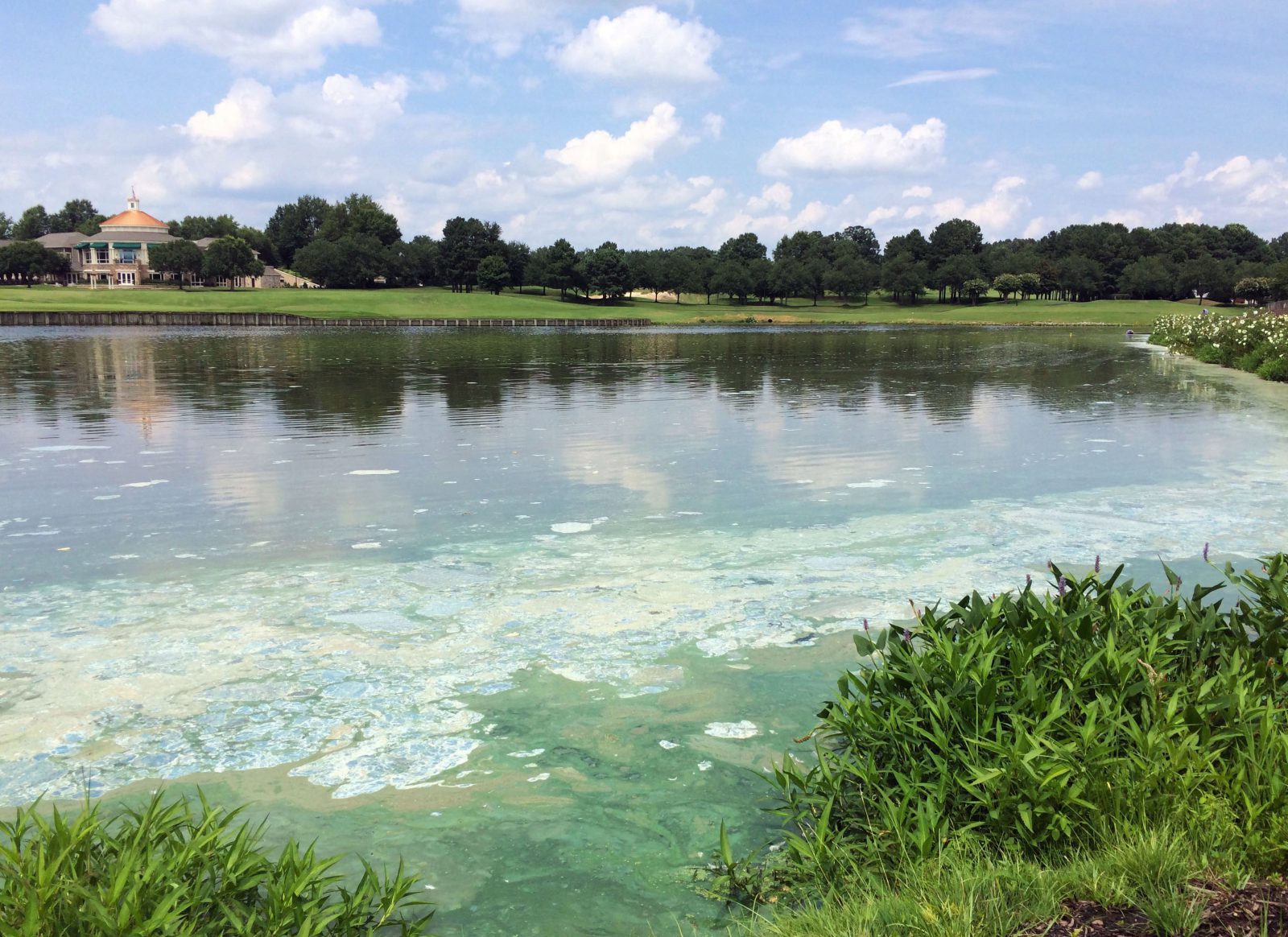
Thanks to advancements in science, biologists nowadays have better methods to maintain an optimal level of productivity throughout the entire growing season, pushing primary productivity of trophy fisheries beyond what was previously possible. Over the years it has become common knowledge to pond owners that algae function as a large food source for aquatic organisms and are a critical component of a pond’s ecosystem. In recognition of this, many pond owners choose to fertilize their ponds to promote overall algal productivity.
But, are the strategies they employ really the most effective approach? Let’s take a closer look.
Productivity is a multi-dimensional term. It refers to stimulating algal growth, as well as the movement of energy and biomass up the food chain to ultimately grow bigger bass. The problem with fertilizing a pond to grow algae is that some algal species do not want to readily give up their lives through the food chain to zooplankton that subsequently support fish communities. These stubborn algae are primarily comprised of cyanobacteria (a.k.a. blue-green algae or cyanos). Unfortunately, in many aquatic systems, these undesirable cyanobacteria dominate rather than beneficial algal species. Despite a pond looking green (or bluish green) and productive, many nutrients can be locked in the cyanobacteria and not passed up the food chain. So, in some cases, we know fertilizer programs employed on ponds can actually promote these stubborn cyanobacteria, and ultimately run the risk of doing more harm than good.
Why does fertilizer tend to fuel cyanobacteria at times rather than beneficial green algae? Data have shown that phosphorus levels and, to a greater extent, the nitrogen to phosphorus ratio (N:P), can be key in governing the type of algae that prevails. Ratios that favor nitrogen are ideal due to their tendency to sustain green algae (think of it as lush, healthy salad for your fish—yum). On the other hand, N:P ratios which favor phosphorus are more likely to promote undesired cyanobacteria (Smith 1983; Seale et al. 1987; Paerl 1990, 1991 Ghadouani et al 2003). Unfortunately, phosphorus is usually the largest component of many amended fertilizers, especially in relation to free nitrogen and if applied when additional phosphorus is not necessary, promotes nuisance cyanobacteria that actually can harm your fish and decrease biomass. Put simply, even though the pond being fertilized turns green and appears to be productive, it may be the wrong type of algae.
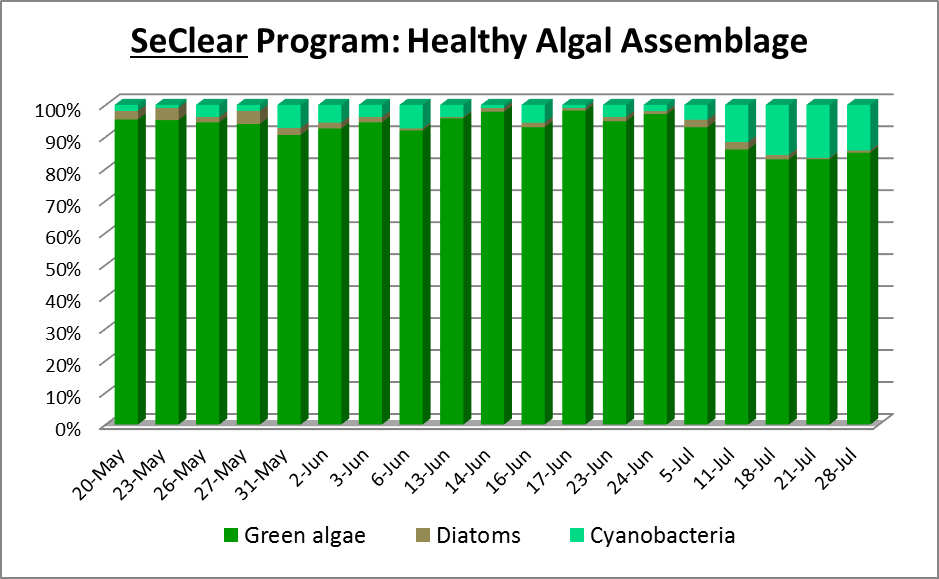
Let’s delve into why cyanobacteria are problematic and why you should re-think the fertility program you implement to grow big bass. The tendency of many forms of cyanobacteria is to produce toxins that can threaten the health of living creatures. Cyanobacteria often form thick scums or mats on the water surface, which can congregate toxins they produce in areas where humans and animals are most likely to come into contact with them. The long-term effects of cyanotoxins are still being researched, but current evidence suggests that exposure could be linked to the development of several neurological diseases later in life.
Although not all cyanobacteria are known to have human health concerns, the occurrence of toxic blooms is on the rise and numerous unknown compounds are continually being discovered – the potential impacts of which may still be unknown and not worth risking.
In most fertilized fisheries, cyanobacteria can typically be found mixed throughout the productive-looking green water among the desirable green algae and zooplankton. The cyanobacteria throughout the water column are comprised of gelatinous colonies, aggregated filaments and other unique structural features, and are actually designed to avoid being consumed (Webster and Peters, 1978; DeMott et al. 2001). Cyanobacteria are actually rather nutrient-poor in terms of lacking essential nutrients for zooplankton growth, and many simply get caught in filtering structures of zooplankton rather than be fully ingested (Lampert 1987). That is perhaps good for the zooplankton because cyanobacteria can cause negative impacts on zooplankton growth rates and ability to reproduce (Kilham et al. 1997). If they are successfully digested, that could lead to even worse ramifications as the internally accumulated cyano-toxins (if present) may be detrimental to their fecundity (fertility) (Lampert 1981, 1982; Reinikainen et al. 1995). Cyanotoxins can also directly impact fish health, in part, through decreased growth, immune function and endocrine disruption (Rogers et al. 2011; Liu et al. 2014). Other metabolites produced by cyanobacteria include taste and odor compounds that can make your pond smell bad and fish taste like musty dirt.
Beneficial zooplankton like Daphnia have been documented to selectively graze on green algae over cyanobacteria (they can pick and choose what they eat), and that ends up giving the cyanobacteria a competitive edge because, over time, they limit competition for light and nutrients (Mitra and Flynn 2006; Wang et al. 2010). This eventually leads to a downward spiral of your algal assemblage that results in a large biomass of cyanobacteria that are not ideal for supporting the food chain. Ultimately, a decrease in fish production is often observed, even though your water looks productive.
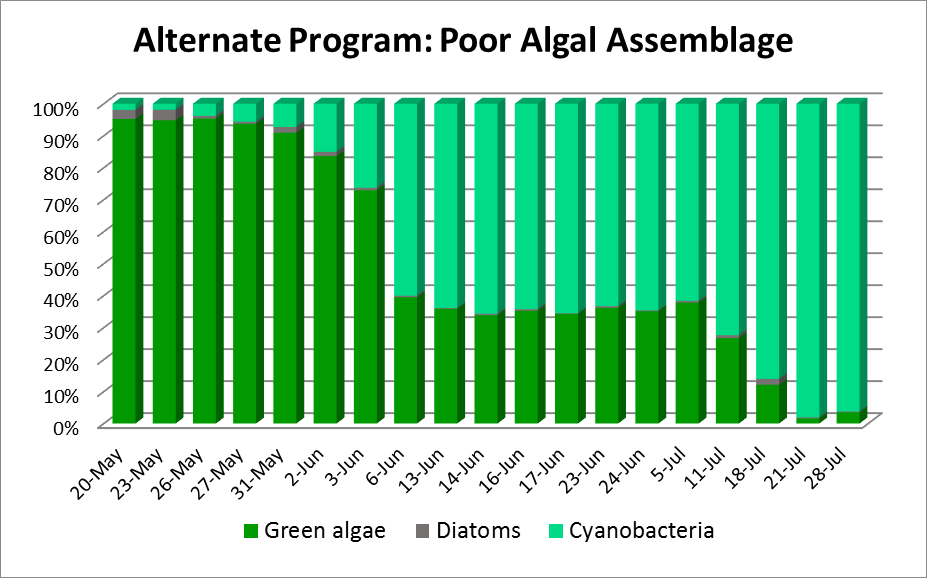
So—is your pond’s bloom out of balance? Does is contain cyanobacteria or beneficial algae? How do you know and what are you doing about it? Luckily there are effective solutions specifically designed to help get cyanobacteria in check. Specifically, products are available to target nuisance cyanobacteria in a diverse algal assemblage while allowing the remaining beneficial algal types to thrive with decreased competition. Think of this method like weeding your garden; where selectively controlling the nuisance weeds (cyanobacteria) can give the desirables increased access to elements needed for growth and a better chance to thrive.
To get started, it’s important to first verify what species of algae are present in your lake or pond. To determine this, a biologist can examine and test a water sample to identify and quantify the species present. If it’s determined that cyanobacteria exceed the desired threshold, copper- or peroxide-based algaecides can be strategically applied to target and kill the cyanobacteria while allowing the majority of green algae to survive the treatment.
For the past three growing seasons, we have been experimenting with various rates of algaecide and fertilizer to shift away from cyanobacteria while promoting healthy, green algae with the goal of increased fish production. The process has been enlightening and understanding new advancements in science as well as recently developed products are key. We are learning that suppressing blue-green algae while promoting green algae is both feasible and practical. We’ve focused on the science of nutrient management in combination with SePRO Corporation’s advanced product technology to zero in on controlling those dreaded cyanobacteria while helping enhance water quality.
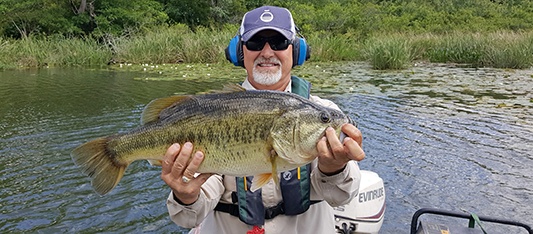
Targeting specific algal activity is part of this process, as is doing what we can to monitor and manage key nutrient levels. Three years of managing several trophy fisheries in both Virginia and Kentucky using these techniques has shown that advanced products can be used reliably to shift to a desirable algal assemblage by killing cyanobacteria, leaving green algae species intact, and promoting nutrient ratios (i.e. Si:P, N:P) that promote beneficial algal types (i.e. diatoms and green algae). Over time, this has helped establish a balanced algal assemblage that supports the food chain, while also decreasing the need for algaecide treatments due to competitive abilities of beneficial algae once blue-greens are selectively controlled.
Nutrients and algal growth are certainly important factors in your lake or pond ecosystem, though the specific nutrient concentrations and ratios should be examined to ensure the environment is conducive to more palatable and beneficial algal types, rather than nuisance cyanobacteria. Simply growing algae is not enough; understanding and maintaining a healthy algal assemblage is critical for ecosystem health, fish production, and human health. With advancements in science comes the opportunity to push bass growth rates further than those pioneers who paved the way for these new opportunities to exist. Research and experience have taught us that if you want to manage your waterbody for big bass, stick with the science and say no to cyanos.
SOLitude Lake Management is an environmental firm committed to providing full-service solutions that improve water quality, preserve natural resources, and reduce our environmental footprint. Our services include lake, pond, wetland and fisheries management programs, algae and aquatic weed control, mechanical harvesting, hydro-raking, installation and maintenance of fountains and aeration systems, water quality testing and restoration, bathymetry, lake vegetation studies, biological assessments, habitat assessments, invasive species management and nuisance wildlife management. Services, consulting and aquatic products are available to clients nationwide, including homeowners associations, multi-family and apartment communities, golf courses, commercial developments, ranches, private landowners, reservoirs, recreational and public lakes, municipalities, parks, and state and federal agencies. Learn more about SOLitude Lake Management and purchase products at www.solitudelakemanagement.com.
References
DeMott, W.R. 1999. Foraging strategies and growth inhibition in five daphnids feeding on mixtures of a toxic cyanobacterium and a green alga. Freshwater Biology, 42: 263-274.
Ghadouani, A., Pinel-Alloul B., Prepas E.E. 2003. Effects of experimentally induced cyanobacterial blooms on crustacean zooplankton communities. Freshwater Biology, 48: 363-381.
Kilham, S.S., Kreeger D.A., Goulden C.E. and Lynn S.G. 1997. Effects of algal food quality on fecundity and population growth rates of Daphnia. Freshwater Biology, 38: 639-647.
Lampert, W. 1981. Inhibitory and toxic effects of bluegreen algae on Daphnia. International Review of Hydrobiology, 66: 285-298.
Lampert, W. 1982. Further studies on the inhibitory effect of the toxic blue-green Microcystis aeruginosa on the filtering rate of zooplankton. Archives of Hydrobiology, 95, 207–220
Lampert, W. 1987. Laboratory studies on zooplankton-cyanobacteria interactions. New Zealand Journal of Marine and Freshwater Research, 21: 483-490
Liu, W., Qiao, Q., Chen, Y. Wu, K. Zhang, X. 2014. Microcystin-LR exposure to adult zebrafish (Danio rerio) leads to growth inhibition and immune dysfunction in F1 offspring, a parental transmission effect of toxicity. Aquatic Toxicology155: 360-367.
Mitra, A. and Flynn K.J. (2006) Promotion of harmful algal blooms by zooplankton predatory activity. Biol. Lett., 2: 194-197.
Paerl, H.W. 1990. Physiological ecology and regulation of N2 fixation in natural waters. Adv. Microb. Ecology, 11:305-344.
Paerl, H.W., Prufert L.E., Ambrose W.W. 1991. Contemporaneous N2 fixation and oxygenic photosynthesis in the nonheterocystous mat-forming cyanobacterium Lyngbya aestuarii. Applied Environmental Microbiology, 57(11):3086-3092.
Reinikainen, M., Kiviranta J., Ulvi V. and Niku-Paavola M.L. 1995. Acute toxic effects of a novel cyanobacterial toxin on the crustaceans Artemia salina and Daphnia pulex. Archives of Hydrobiology, 133: 61-69.
Rogers, E.D., Henry, T.B., Twiner, M.J., Gouffon, J.S., McPherson, J.T., Boyer, G.L., Sayler, G.S., Wilhelm, S.W., 2011. Global gene expression profiling in larval zebrafish exposed to microcystin-LR and microcystis reveals endocrine disrupting effects of Cyanobacteria. Environ. Sci. Technol. 45: 1962-1969.
Seale, D.B., Boraas M.E. and Warren G.J. 1987. Effects of sodium and phosphate on growth of cyanobacteria . Water Research, 21(6): 625-631
Smith, V.H. 1983. Low Nitrogen to Phosphorus ratios favor dominance by blue-green algae in lake phytoplankton. Science, 221:669-671.
Smith, V.H., Tilman, G.D., Nekola, J.C. 1999. Eutrophication: Impacts of excess nutrient inputs on freshwater, marine, and terrestrial ecosystems. Environ. Pollut. 100: 179-196.
Wang, X., Qin B., Gaoand G. and Paerl H.W. 2010. Nutrient enrichment and selective predation by zooplankton promote Microcystis (Cyanobacteria) bloom formation. Journal of Plankton Research, 32(4): 457-470.
Webster, K.E. and Peters R.H. 1978. Some size-dependent inhibitions of larger cladoceran filterers in filamentous suspensions. Limnology









